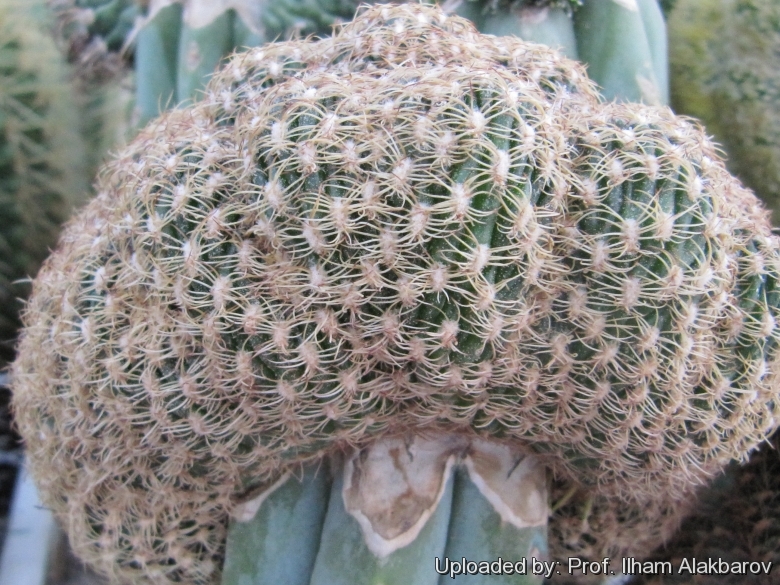Accepted Scientific Name: Echinopsis tiegeliana (Wessner) D.R.Hunt
Bradleya 9: 88. 1991

Lobivia pusilla f. cristata Photo by: Prof. Ilham Alakbarov
Origin and Habitat: Garden origin (Nursery produced cultivar)
Synonyms:
See all synonyms of Echinopsis tiegeliana
back
Accepted name in llifle Database:Echinopsis tiegeliana (Wessner) D.R.HuntBradleya 9: 88. 1991Synonymy: 34
back
Description: Echinopsis tiegelianaSN|20965]]SN|20965]] var. pusilla firstly described as Lobivia pusillaSN|20978]]SN|20978]] is an hight altitude form of the wide ranging and very variable Echinopsis tiegelianaSN|20965]]SN|20965]] distinguished by smaller stems only 40 mm tall and shorter spines.
Crested form: The crested form (Echinopsis tiegelianaSN|20965]]SN|20965]] var. pusilla f. cristata|SN|26121]]) - despite to its beauty - is very rare and sought after by collectors, for its unique features. It is a small low growing crested cactus that will slowly forms tangled groups up to 20 cm (or more ) in diameter with age. The plant tends to grow seated in substrate, but in cultivation it is almost always seen grafted on columnar cacti. There are several crested clones.
Stems: Yellow, spherical more or less flattened usually less than 4 cm tall in habitat (but often larger in cultivation). It has up to 20 ribs, with raised tubercles between which the areoles appear. The tubercles are spirally arranged on the stem's surface.
Spines: Arranged like little spiders, cream coloured, yellowish or brownish, turning greyish eventually.
Flowers: Mostly deep red.
Subspecies, varieties, forms and cultivars of plants belonging to the Echinopsis tiegeliana group
Bibliography: Major references and further lectures
1) Nathaniel Lord Britton, Joseph Nelson Rose “Cactaceae: Descriptions and Illustrations of Plants of the Cactus Family” Courier Dover Publications, 1963
2) James Cullen, Sabina G. Knees, H. Suzanne Cubey “The European Garden Flora Flowering Plants: A Manual for the Identification of Plants Cultivated in Europe, Both Out-of-Doors and Under Glass” Cambridge University Press, 11/Aug./2011
3) David Hunt, Nigel Taylor “The New Cactus Lexicon” DH Books, 2006
4) Edward F. Anderson “The Cactus Family” Timber Press, 2001
5) Clive Innes, Charles Glass “Cacti” Portland House, 01/May/1991
Cultivation and Propagation: Echinopsis tiegelianaSN|20965]]SN|20965]] var. pusilla f. cristata|SN|26121]] is not too difficult in a greenhouse, although grows quite slowly. It is usually seen as a grafted plant but can grow on its own roots too.
Soil: Use a mineral well permeable soil with little organic matter (peat, humus).
Exposure: They need a good amount of light shade to full sun this help to keep the plants healthy, although slow growth.
Watering: Water sparingly from March till October (weekly during summertime, if the weather is sunny enough), with a little fertilizer added. Less or no water during cold winter months, or when night temperatures remain below 10° to prevent root loss. It is sensitive to overwatering (rot prone).
Fertilization: Feeding may not be necessary at all if the compost is fresh then, feed in summer only if the plant hasn't been repotted recently. Do not feed the plants from September onwards as this can cause lush growth which can be fatal during the darker cold months.
Hardiness: Keep perfectly dry in winter at temperatures from 5 to 15 degrees centigrade. (but it is relatively cold resistant and hardy to -5° C, or possibly colder for short periods) In the rest period no high atmospheric humidity!! (Temperature Zone: USDA 9-11)
Crested growth: Unlike 'monstrose' varieties of plants, where the variation from normal growth is due to genetic mutation, crested growth can occur on normal plants. Sometimes it's due to variances in light intensity, or damage, but generally the causes are unknown. A crested plant may have some areas growing normally, and a cresting plant that looks like a brain, may revert to normal growth for no apparent reason. If you have any of the crested part left you need to remove the normal growth and leave the crested part behind this will need to be done regularly.
Propagation: Grafting or cuttings. Plants are usually grafted onto column-shaped cacti but proved to be able to produce their own roots if degrafted. Cuttings will take root in a minimum temperature of 20° C (but better in hot weather). Cuttings of healthy shoots can be taken in the spring and summer. Cut the stem with a sharp, sterile knife, leave the cutting in a warm, dry place for a week or weeks (depending on how thick the cutting is) until a callus forms over the wound. Once the callus forms, the cutting may be inserted in a container filled with firmed cactus potting mix topped with a surface layer of coarse grit. They should be placed in the coarse grit only; this prevents the cut end from becoming too wet and allows the roots to penetrate the rich compost underneath. The cuttings should root in 2 to 6 weeks. Large crested piece must be placed on the soil surface without burying the plant base down in the soil.










